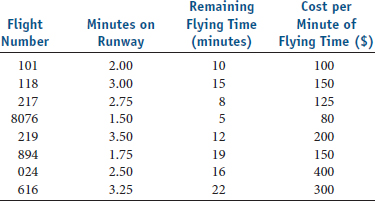CASE: Air Traffic Controller School (ATCS)
ATCS provides training for future air traffic controllers. One of the skills air traffic controllers need is the ability to sequence aircraft for landing purposes. The controller decides who lands immediately and who goes into a holding pattern. The following data are provided to you, the student, to develop an acceptable landing sequence. Any sequence that results in an aircraft not being scheduled to land before it runs out of remaining flying time is unacceptable. The following aircraft are currently awaiting your decision as to their landing sequence.

There are many ways to sequence this group of aircraft waiting to land. Since cost is an obvious factor, consider a sequence that minimizes total cost to land the aircraft. Multiply the cost per minute of flying time by the remaining number of minutes. This gives you the maximum cost associated with an airplane circling in a holding pattern until the last possible moment.
(a) Develop a landing sequence that gives priority to those aircraft with the highest cost of slack time (excess flying time multiplied by cost per minute of flying time). For example, Flight 616's 18.75 minutes of slack time (22 2 3.25) times $300 per minute means that if Flight 616 does not land until its time is all used up, it incurs an extra flying cost of $5,625. Make a Gantt chart showing the landing sequence and ...
Get Operations Management: An Integrated Approach, 5th Edition now with the O’Reilly learning platform.
O’Reilly members experience books, live events, courses curated by job role, and more from O’Reilly and nearly 200 top publishers.

